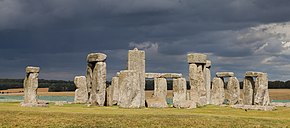സ്റ്റോൺഹെൻജ്
ഇംഗ്ലണ്ടിലെ ഒരു ചരിത്രാതീതകാല സ്മാരകമാണ് സ്റ്റോൺഹെൻജ്. ലണ്ടൻ നഗരത്തിൽ നിന്ന് 140 കിലോമീറ്റർ അകലെയായി വിൽറ്റ്ഷിർ കൗണ്ടിയിലെ ഈംസ്ബെറി(Amesbury)യിലാണ് ഈ സ്മാരകം നിലനിൽക്കുന്നത്. വൃത്താകൃതിയിൽ നാട്ടിനിർത്തിയിരിക്കുന്ന രീതിയിൽ ക്രമീകാരിച്ചിട്ടുള്ള വലിയ കല്ലുകളാണ് ഇവിടെയുള്ളത്. ഈ കല്ലുകൾ ഒരോന്നിനും ഏകദേശം 13 അടി (4 മീറ്റർ) ഉയരവും 7 അടി (2.1 മീറ്റർ) വീതിയും 25 ടൺ ഭാരവും ഉണ്ട്. നവീനശിലായുഗത്തിലോ വെങ്കലയുഗത്തിലോ ആയിരിക്കും ഇത് നിർമ്മിച്ചതെന്ന് കരുതുന്നു. നൂറുകണക്കിന് ടുമുലി (ശ്മശാന കുന്നുകൾ) ഉൾപ്പെടെ ഇംഗ്ലണ്ടിലെ നിയോലിത്തിക്ക്, വെങ്കലയുഗ സ്മാരകങ്ങളുടെ ഏറ്റവും ഇടതൂർന്ന സമുച്ചയത്തിന് നടുവിലെ മൺതിട്ടകളിലാണ് കല്ലുകൾ സ്ഥാപിച്ചിരിക്കുന്നത്. [1]
 സ്റ്റോൺഹെൻജ് 2014-ൽ | |
| സ്ഥാനം | വിൽറ്റ്ഷിർ, ഇംഗ്ലണ്ട് |
|---|---|
| Coordinates | 51°10′43.84″N 1°49′34.28″W / 51.1788444°N 1.8261889°W |
| Official name | Stonehenge, Avebury and Associated Sites |
| Type | സാംസ്കാരികം |
| Criteria | i, ii, iii |
| Designated | 1986 (10th session) |
| Reference no. | 373 |
| Region | യൂറോപ്പ് - വടക്കൻ അമേരിക്ക |
ബി.സി.ഇ. 3000നും ബി.സി.ഇ.2000നും ഇടയിലായിരിക്കും ഇതിന്റെ നിർമ്മിതി എന്ന് പുരാവസ്തുഗവേഷകർ കരുതുന്നു. റേഡിയോ കാർബൺ പഴക്ക നിർണ്ണയ പ്രകാരം ഇവയിൽ ചില കല്ലുകൾ ബി.സി.ഇ. 3000-ത്തിൽ തന്നെ ഈ പ്രദേശത്തെത്തിയതായും 2400 നും ബി.സി.ഇ. 2200 ഇടയിലായി ഇവ നാട്ടിയതായും അനുമാനിക്കുന്നു.
സ്റ്റോൺഹെൻജ് ആരു നിർമ്മിച്ചു എന്നോ എന്തിനു വേണ്ടി നിർമ്മിച്ചു എന്നോ എത്രകാലം ഇവിടെ മനുഷ്യവാസം നിലനിന്നിരുന്നു എന്നോ ഗവേഷകർക്ക് ഇനിയും കണ്ടെത്താനായിട്ടില്ല. എന്നാൽ കരുതപ്പെടുംപോലെ സ്റ്റോൺഹെൻജ് ഒരു പ്രാചീന ജ്യോതിശാസ്ത്ര ഘടികാരമോ നിരീക്ഷണാലയമോ അല്ല, ഇതൊരു ശ്മശാനമായിരുന്നുവെന്നും പിന്നീട് വലിയൊരു ഉത്സവമേളയുടെ വേദിയാവുകയും ചെയ്തുവെന്ന് പുതിയ പഠനങ്ങൾ പറയുന്നു.
ബ്രിട്ടൺറന്റെ സാംസ്കാരിക മുദ്രകളിലൊന്നായി ഗണിക്കപ്പെടുന്ന സ്റ്റോൺഹെൻജിനെ ഇംഗ്ലണ്ട് 1882 മുതൽ സംരക്ഷിത സ്മാരകങ്ങളുടെ പട്ടികയിൽ ഉൾപ്പെടുത്തി സംരക്ഷിച്ചു പോരുന്നു. 1986 മുതൽ യുനെസ്കോ സ്റ്റോൺഹെൻജും ചുറ്റുപാടും ലോകപൈതൃകസ്ഥാനങ്ങളുടെ പട്ടികയിൽ ഉൾപ്പെടുത്തി.[2][3]
അവലംബം
തിരുത്തുക- ↑ Young, Christopher & Chadburn, Amanda & Bedu, Isabelle (July 2008). "Stonehenge World Heritage Site Management Plan". UNESCO: 18.
{{cite journal}}: CS1 maint: multiple names: authors list (link) - ↑ "History of Stonehenge". English Heritage. Archived from the original on 2 June 2016. Retrieved 7 June 2016.
The monument remained in private ownership until 1918 when Cecil Chubb, a local man who had purchased Stonehenge from the Antrobus family at an auction three years previously, gave it to the nation. Thereafter, the duty to conserve the monument fell to the state, today a role performed on its behalf by English Heritage.
- ↑ "Ancient ceremonial landscape of great archaeological and wildlife interest". Stonehenge Landscape. National Trust. Archived from the original on 18 June 2008. Retrieved 17 December 2007.
പുറംകണ്ണികൾ
തിരുത്തുകവിക്കിവൊയേജിൽ നിന്നുള്ള സ്റ്റോൺഹെൻജ് യാത്രാ സഹായി
- Stonehenge English Heritage official site: access and visiting information; research; future plans
- Skyscape- live webfeed
- 360° panoramic English Heritage: interactive view from the centre
- Stonehenge Landscape The National Trust – Information about the surrounding area.
- Stonehenge Today and Yesterday By Frank Stevens, at Project Gutenberg.
- The History of Stonehenge BBC animation of the monument's construction.
- On the Etymology of the word Stone-henge. By Edwin Guest, Esq.
- Stonehenge, a Temple Restor'd to the British Druids By William Stukeley, at Sacred Texts.
- Stonehenge, and Other British Monuments Astronomically Considered By Norman Lockyer, at Sacred Texts.
- Glaciers and the bluestones of Wales Archived 2012-04-18 at the Wayback Machine. British Archaeology essay about the bluestones as glacial deposits.
- Stonehenge Twentieth Century Excavations Databases Archived 2010-12-17 at the Wayback Machine. An English Heritage commissioned report by Wessex Archaeology on the twentieth century excavations.
- Stonehenge: Stones being repositioned during restoration work in 1914
- Reconstruction work in the 1950s